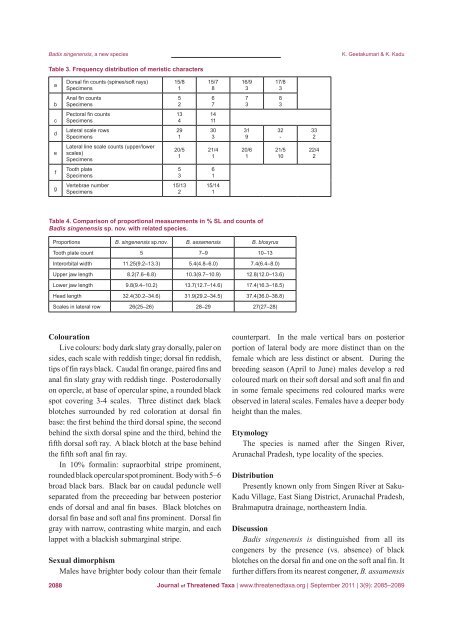<strong>Badis</strong> <strong>singenensis</strong>, a <strong>new</strong> <strong>species</strong>K. Geetakumari & K. KaduTable 3. Frequency distribution <strong>of</strong> meristic charactersaDorsal fin counts (spines/s<strong>of</strong>t rays)Specimens15/8115/7816/9317/83bAnal fin countsSpecimens52677383cPectoral fin countsSpecimens1341411dLateral scale rowsSpecimens29130331932-332eLateral line scale counts (upper/lowerscales)Specimens20/5121/4120/6121/51022/42fTooth plateSpecimens5361gVertebrae numberSpecimens15/13215/141Table 4. Comparison <strong>of</strong> proportional measurements in % SL and counts <strong>of</strong><strong>Badis</strong> <strong>singenensis</strong> sp. nov. with related <strong>species</strong>.Proportions B. <strong>singenensis</strong> sp.nov. B. assamensis B. blosyrusTooth plate count 5 7–9 10–13Interorbital width 11.25(9.2–13.3) 5.4(4.8–6.0) 7.4(6.4–8.0)Upper jaw length 8.2(7.6–8.8) 10.3(9.7–10.9) 12.8(12.0–13.6)Lower jaw length 9.8(9.4–10.2) 13.7(12.7–14.6) 17.4(16.3–18.5)Head length 32.4(30.2–34.6) 31.9(29.2–34.5) 37.4(36.0–38.8)Scales in lateral row 26(25–26) 28–29 27(27–28)ColourationLive colours: body dark slaty gray dorsally, paler onsides, each scale with reddish tinge; dorsal fin reddish,tips <strong>of</strong> fin rays black. Caudal fin orange, paired fins andanal fin slaty gray with reddish tinge. Posterodorsallyon opercle, at base <strong>of</strong> opercular spine, a rounded blackspot covering 3-4 scales. Three distinct dark blackblotches surrounded by red coloration at dorsal finbase: the first behind the third dorsal spine, the secondbehind the sixth dorsal spine and the third, behind thefifth dorsal s<strong>of</strong>t ray. A black blotch at the base behindthe fifth s<strong>of</strong>t anal fin ray.In 10% formalin: supraorbital stripe prominent,rounded black opercular spot prominent. Body with 5–6broad black bars. Black bar on caudal peduncle wellseparated from the preceeding bar between posteriorends <strong>of</strong> dorsal and anal fin bases. Black blotches ondorsal fin base and s<strong>of</strong>t anal fins prominent. Dorsal fingray with narrow, contrasting white margin, and eachlappet with a blackish submarginal stripe.Sexual dimorphismMales have brighter body colour than their femalecounterpart. In the male vertical bars on posteriorportion <strong>of</strong> lateral body are more distinct than on thefemale which are less distinct or absent. During thebreeding season (April to June) males develop a redcoloured mark on their s<strong>of</strong>t dorsal and s<strong>of</strong>t anal fin andin some female specimens red coloured marks wereobserved in lateral scales. Females have a deeper bodyheight than the males.EtymologyThe <strong>species</strong> is named after the Singen River,Arunachal Pradesh, type locality <strong>of</strong> the <strong>species</strong>.DistributionPresently known only from Singen River at Saku-Kadu Village, East Siang District, Arunachal Pradesh,Brahmaputra drainage, northeastern India.Discussion<strong>Badis</strong> <strong>singenensis</strong> is distinguished from all itscongeners by the presence (vs. absence) <strong>of</strong> blackblotches on the dorsal fin and one on the s<strong>of</strong>t anal fin. Itfurther differs from its nearest congener, B. assamensis2088<strong>Journal</strong> <strong>of</strong> <strong>Threatened</strong> <strong>Taxa</strong> | www.threatenedtaxa.org | September 2011 | 3(9): 2085–2089
<strong>Badis</strong> <strong>singenensis</strong>, a <strong>new</strong> <strong>species</strong>in having fewer tooth plates (5 vs. 7–9), scales inlateral row (25–26 vs. 28–29); wider interorbitalregion (9.2–13.3 vs. 4.8–6.0% SL); shorter upper jaw(7.6–8.8 vs.9.7–10.9% SL) and lower jaw (9.4–10.2vs. 12.7–14.6% SL). It is also distinguished from B.blosyrus in having fewer tooth plates (5 vs. 10–13);less scales in lateral row (25–25 vs. 27–28); shorterhead length (30.2–34.6 vs. 36.0–38.8% SL); widerinterorbital space (9.2–13.3 vs. 6.4–8.0% SL); shorterupper jaw (7.6–8.8 vs.12.0–13.6%SL) and lower jaw(9.4–10.2 vs. 16.3–18.5%SL).<strong>Badis</strong> <strong>singenensis</strong> differs from its congeners fromthe Brahmaputra basin, viz., B. badis, B. dibruensis, B.kanabos and B. tuivaiei by the presence (vs. absence)<strong>of</strong> black blotch on the s<strong>of</strong>t anal fin. It further differsfrom B. badis in having wider interorbital space (9.2–13.3 vs. 6.5–8.3% SL) and shorter lower jaw (9.4–10.2vs. 11.3–14.5% SL). It also differs from B. dibruensisin having longer upper jaw (7.6–8.8 vs. 6.1–6.9% SL)and lower jaw (9.4–10.2 vs. 7.8–8.3% SL). It furtherdiffers from B. kanabos in having wider interorbitalspace (9.2–13.3 vs. 7.3–8.6% SL) and shorter lowerjaw (9.4–10.2 vs. 11.0–13.5% SL). It also furtherdiffers from B. tuivaiei in having wider interorbitalspace (9.2–13.3 vs. 5.6–7.2% SL) and shorter lowerjaw (9.4–10.2 vs 10.9–16.4).The <strong>new</strong> <strong>species</strong> differs from all the five <strong>species</strong> <strong>of</strong>the Irrawaddy drainage in the presence (vs. absence)<strong>of</strong> opercle blotch and in the presence (vs. absence) <strong>of</strong>black blotch on the s<strong>of</strong>t dorsal fin. It further differsfrom B. ferrarisi in having longer interorbital width(9.2–13.3% SL) and longer lower jaw (11.3–12.8 vs.9.4–10.2% SL).<strong>Badis</strong> <strong>singenensis</strong> also differs from B. siamensisand B. khwae in the absence (vs. presence) <strong>of</strong> opercleblotch and from B. chittagongis in absence (vs.presence) <strong>of</strong> opercle blotch.Kullander & Britz (2002) classified the <strong>species</strong> <strong>of</strong><strong>Badis</strong> into five groups viz., B. ruber, B. assamensis, B.K. Geetakumari & K. Kaducorycaeus, B. kyar and B. badis group. They reportedB. assamensis group to be characteristic in havingan opercle blotch and believed that more numbers <strong>of</strong>undescribed <strong>species</strong> <strong>of</strong> the group exist in the region.The <strong>new</strong> <strong>species</strong> under description belongs to the B.assamensis group.Comparative materials<strong>Badis</strong> assamensis: MUMF Per-51-54, 4, 41.6–55.8mm SL; India; Assam, Dibrugarh, Dibru River; <strong>Badis</strong>assamensis: RGUMF-0180, 2, 49–52 mm SL, Dibangriver, Lohit, Arunachal Pradesh, India; B. badis:MUMF Per-55-65, 11, 23.5–28.7 mm SL; India;Manipur, Barak River; <strong>Badis</strong> badis: RGUMF- 0149,5, 23–40 mm SL, Mebang River, Arunachal Pradesh,India; B. blosyrus: MUMF Per-66-68, 3, 36.8–38.9mm SL; India; Arunachal Pradesh, Lohit River; B.dibruensis: MUMF- Per 95, Holotype, 1, 37.3mm SL;India; Assam, Dibrugarh, Dibru River; B. ferrarisi:MUMF Per- 69-75, 7, 32.0–44.0 mm SL; India;Manipur, Lokchao River; B. kanabos: MUMF Per-76-81, 6, 48.7–54.9 mm SL; India; Manipur, Barak River;B. tuivaiei: MUMF 5125-5132, 8, 53.5–59.4 mm SL;India; Manipur, Tuivai and Irang River.ReferencesGreenwood, P.H. (1976). A review <strong>of</strong> the family centropomidae(Pisces, Perciformes). Bulletin <strong>of</strong> the British Museum(Natural History) 29(1): 1–81.Hollister, G. (1934). Clearing and dyeing <strong>fish</strong> for bone study.Zoologica 12: 89–101.Kullander, S.O. & R. Britz (2002). Revision <strong>of</strong> the familyBadidae (Teleostei: Perciformes), with description <strong>of</strong> a <strong>new</strong>genus and ten <strong>new</strong> <strong>species</strong>. Ichthyological Exploration <strong>of</strong>Freshwaters 13(4): 295–372.<strong>Journal</strong> <strong>of</strong> <strong>Threatened</strong> <strong>Taxa</strong> | www.threatenedtaxa.org | September 2011 | 3(9): 2085–20892089
















